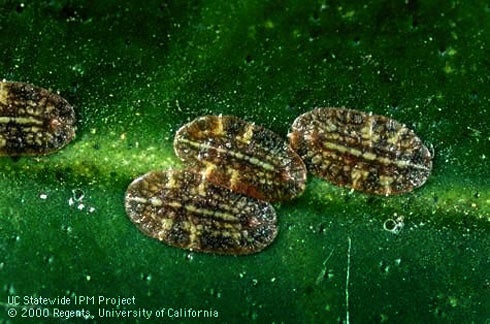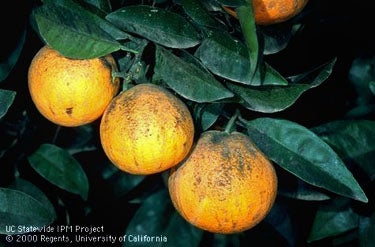Citricola Scale, Coccus psuedomagnoliarum
The Situation: In California, citricola scale is a serious pest . This pest is a particular nuisance in the San Joaquin Valley when broad-spectrum pesticide use is reduced as these insecticides typically keep this pest under good control. It was also a serious pest in the inland areas of southern California until 1935, when Metaphycus luteolus, was used to suppressed it. Citricola scale was introduced into California from Asia and now occurs in Japan, California, Australia, the Mediterranean basin, and the Caucasus region of Russia. In California, the scale has a single generation each year. Currently, natural enemies attacking citricola scale in the San Joaquin Valley are not completely effective and there is good opportunity for improved biological control of this pest.
Damage: Citricola scale infests leaves when it is young but moves to the young branches in late autumn or early winter where it matures. It sucks the sap from leaves and branches and produces a sugary exudate referred to as honeydew that drips onto the leaves and fruit. At moderate scale densities, honeydew supports fungal growth (black sooty mold) which downgrades or results in fruit being culled in the packinghouse. At higher densities, Citricola scale decreases fruit size and substantially decreases fruit production the following season.
Economic Impact: Citrus is one of the 10 most important agricultural crops in California, with an annual value of $700-$900 million. The San Joaquin Valley produces about 65% of the citrus grown in the state. This percentage will increase as more of the citrus in the inland coastal valleys is eliminated by urbanization. Citricola scale control costs about $50-$75 per acre per treatment. Control of high populations often requires a second treatment.
Distribution: Citricola scale is rare in the inland and coastal valleys of southern California. In the San Joaquin Valley, as citrus growers adopt IPM using selective pesticides and Aphytis melinus (an insectary-reared parasitoid) releases for California red scale control, citricola scale is becoming an increasingly important pest.
Research: The University of California at Riverside is developing an integrated pest management program for citricola scale control that:
- Tests the value of releasing natural enemies in the late fall and winter and in early spring (augmentative biological control).
- Seeks to locate an effective natural enemy of the scale in its native home (China) or in other countries with effective natural enemies.
- As an interim measure, schedules pesticide applications in late fall when they will least affect natural enemies suppressing other citrus pests.
Center for Invasive Species Research, University of California Riverside
Text and provided by Robert F. Luck , updated by Mark Hoddle Department of Entomology, University of California, Riverside Photos courtesy of Regents of University of California and UC Integrated Pest Management Program
Robert Luck, Professor of Entomology
robert.luck@ucr.edu
Mark Hoddle, Extension Specialist and Director of Center for Invasive Species Research
mark.hoddle@ucr.edu
Personal Website



